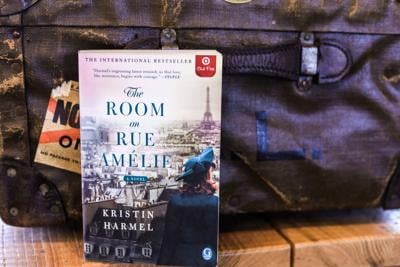“The Room on Rue Amélie” is a thrilling fiction novel by Kristin Harmel set in Paris during World War II. Girl power, courage and strength are some of the dominant themes as an unusual pair joins forces to defy Nazi invaders and prevent fascism from spreading through their beloved city.
Harmel begins the novel with a man reminiscing with his ailing wife about their time together after they met during the war while admiring the first red poppy flower of the season. As Harmel goes back in time to tell the story of Ruby Henderson, she hooks readers from the first couple pages as they’re left wondering who the elderly couple is.
Ruby Henderson left New York City in 1939 to start a new life with her Parisian husband, Marcel Benoit. She dreamed of strolls along the Seine as the Eiffel Tower twinkled in the distance. However, a dark cloud hung over Ruby’s perfect Parisian nights — the threat of Adolph Hitler’s terror.
Harmel enchants readers with Ruby’s character. In the beginning of the novel, Ruby establishes herself as a college-educated and politically aware woman. She recognizes the darkness brewing in Europe, despite the fact that her father and husband dismiss her concerns as silly nonsense.
Ruby doesn’t let the opinions of others diffuse her independence. She goes against her parents’ wishes multiple times by moving far from home for school and love, and she joins the escape line against the wishes of her husband and his associates. Ruby’s husband had the stereotypical belief that war was no place for a girl and refused to even discuss the war with Ruby, but she believed in herself and fought for her beliefs and rights.
Ruby has an unlikely partner helping her hide Allied soldiers that come her way, a young Jewish girl named Charlotte who lives down the hall from her apartment. Charlotte embodies the same independent and courageous personality as Ruby and is wise beyond her years. Her character and faith are put to the test in unimaginable ways, yet she never breaks.
Together, Ruby and Charlotte risk their lives as they fight for freedom and help hundreds of soldiers return to safety. When Ruby falls in love with Thomas, one of the soldiers seeking refuge in her closet, they vow to find each other when the war’s over and move back to Ruby’s California home, where fields of poppy flowers bloom like wildfire.
Thomas’ character feels mediocre and only exists to maintain a romantic component once Ruby’s husband dies. After he leaves Ruby’s stop on the escape line, all Thomas thinks about is getting back to her; he almost seems eager for his plane to be shot down again because he views it as a means to get back to Ruby. He doesn’t add substantive content to the story, and Harmel could’ve spent more time introducing him and building up his character.
The perils of working on the escape line eventually catch up to Ruby and Charlotte, threatening to reveal Charlotte’s Jewish faith and destroy Ruby’s future with Thomas. Even after the two girls are separated, their fight continues; but instead of fighting to save others, they’re fighting to save themselves. The book ends where it began, with the elderly couple and the field of poppy flowers, but a plot twist at the very end might leave readers shocked.
The contrast of lightness and darkness is a major theme throughout the novel. Marcel’s secretiveness symbolizes the distrust and uncertainty caused by war and is starkly contrasted by Ruby’s optimism and courage; her friendship with Charlotte symbolizes hope and perseverance and a light at the end of the tunnel.
Although only mentioned a few times throughout the story, the field of red poppy flowers are also symbolic. Flowers can be a symbol of freedom and growth, and red can symbolize strength, determination, war and love, common traits possessed by both Ruby and Charlotte and more broadly by the Allied powers during the war.
Ruby and Charlotte will inspire readers with their defiance of gender norms and selfless fight against evil, despite the personal risks involved. This book combines history, fiction and romance, and it's a thrilling and personal insight as to what life was like during World War II for minorities.
The next book will be ‘Where the Crawdads Sing’ by Delia Owens. To request a specific book, contact thebreezeculture@gmail.com. For more book reviews, follow the culture desk on Twitter @Breeze_Culture.



